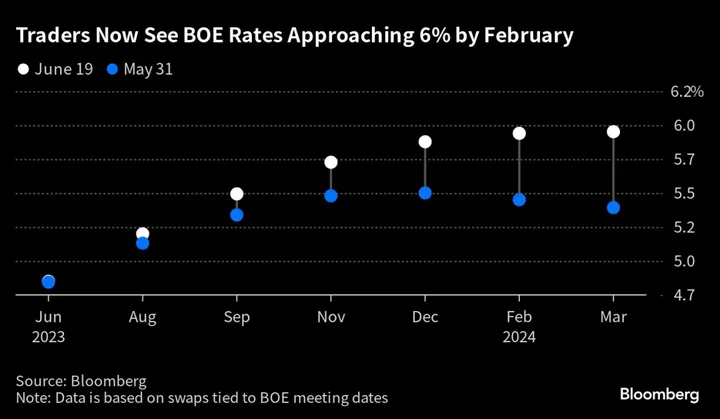Women are bearing the brunt of Britain’s struggle to stamp out a stubborn dose of inflation, the country’s leading gender economists warned ahead of figure likely to show underlying price pressures stuck at their highest in 30 years.
Experts said disparities between the genders threaten to widen as some groups, including women, feel the pain of the spiraling cost of everyday products and soaring interest rates more than others.
Official data on Wednesday are likely to show the hit from inflation is unlikely to abate soon, with economists forecasting that core inflation — the closely watched measure that excludes food and energy prices — lingering at 6.8%, more than triple the Bank of England’s target. That’s fed expectations the central bank will raise interest rates through the summer, starting with a quarter-point increase on Thursday.
Even before a squeeze on living standards pushed swathes of the public closer to breaking point, women were more vulnerable to poverty than the broader population. They’re more likely to be in part-time, or lower-paid work, or not in employment at all, often shouldering the weight of caring responsibilities for family.
“The cost-of-living crisis has deepened existing inequalities, and women are being hit hardest,” said Alesha De-Freitas, head of policy for the Fawcett Society, a charity promoting gender equality. “The simple fact is women are less economically secure than men and feel financial bumps in the road more acutely.”
Women’s Work
One key reason why women are more vulnerable is the nature of their work and pay.
A chasm in employment rates between the two genders has closed markedly in recent decades to just 7 percentage points. But that shift belies the fact that women still work at least a quarter fewer weekly hours than men.
Those figures expose a gulf between the share of men and women working full-time and part-time, which typically pays less per hour. Official government data shows that 38% of women in employment work part-time while just 14% of men do. Women are also more likely to be on a zero-hours contract.
“A big gendered difference when it comes to the cost of living crisis is women’s ability to increase their hours of work,” said Sara Reis, head of research and policy of the UK Women’s Budget Group, an organization promoting a gender equal economy. “They have less flexibility than men because they’re usually the ones with caring responsibilities and also because of the high cost of childcare.”
Research from the charity the Fawcett Society showed that 35% of women want to work more hours but can’t because of a lack of flexible working options and affordable childcare.
Women also typically earn less than men — the gender pay gap stands at 8.3% for full-time workers, according to the Office for National Statistics.
“When you put it all together you do find that you see that women are worse affected than men,” said Vicky Pryce, an economist and former joint head of the UK’s Government Economic Service. “Of course quite a lot of them rely on their other half or whoever to make up for it. But it means that as households they are poorer than would otherwise be the case. They are worse affected because the poorer the household, the more they spend on energy and food.”
Almost two-thirds of public sector workers are women, the epicenter of yet-to-be resolved pay battles between the government and unions. While pay growth excluding bonuses in the public sector rose 5.6% in the three months to April compared to a year ago, the fastest pace since 2003, wages in the private sector jumped 7.6%.
Interest Rates
Rising interest rates also have an outsized impact on women.
“The gender pay gap and unequal caring responsibilities typically mean women can’t save as much as men, therefore any rises in interest rates typically affect them negatively,” said De-Freitas from the Fawcett Society. “Those with mortgages or debt will see their outgoings rise along with interest rates.”
Research by Legal & General last November found that working women and men have similar debt levels. However, the average working woman had £1,801 in savings and investments compared to £3,214 for men. When it comes to pensions, women had just £69,000 saved in their pension pots by the age of 65 in 2021, compared to an average of £205,800 for men, according to a report by Now: Pensions, a workplace pension provider.Poverty
The gaps on pay and hours worked mean that women are more likely to be in poverty than men, particularly among pensioners. That crisis has been years in the making, through changes to the benefit system, which also hit women hardest, said Zaiba Qureshi, chief executive of the charity Housing for Women. “It’s almost like there’s no amount of budgeting support or helping them to manage their income,” she said.
While the Bank of England has not published any specific research or commented on whether the cost-of-living crisis affects genders differently, Governor Andrew Bailey acknowledged following the latest rates decision the outsized impact for those on a lower income.
“We are very sensitive to the position of people — all people — but particularly people on lower incomes,” Bailey said in May. “This inflation is particularly difficult for those least well off because it is concentrated ... in what I call the essentials of life.”
--With assistance from Andrew Atkinson.
Author: Tom Rees and Olivia Konotey-Ahulu

